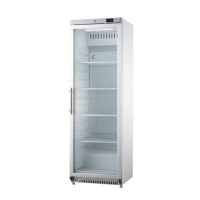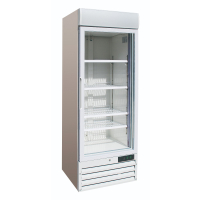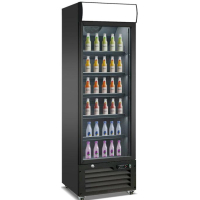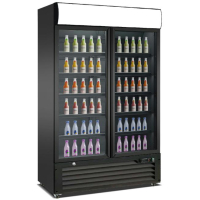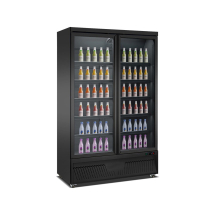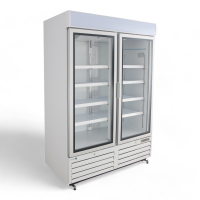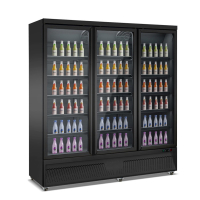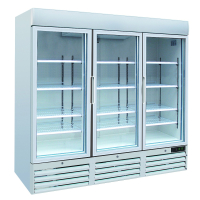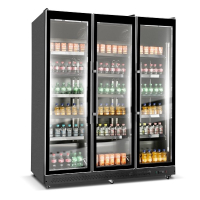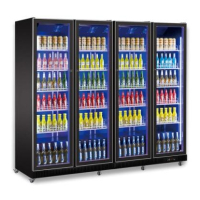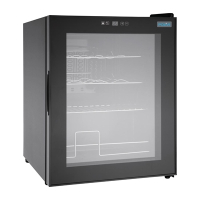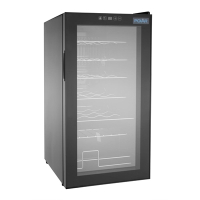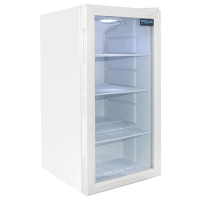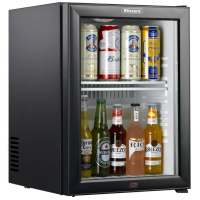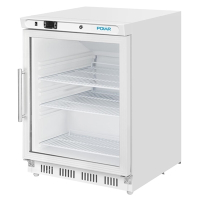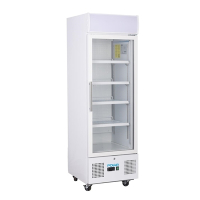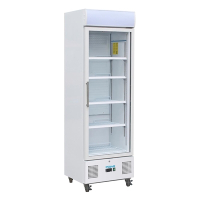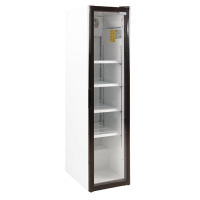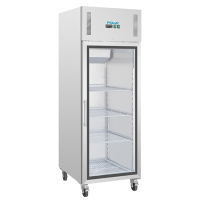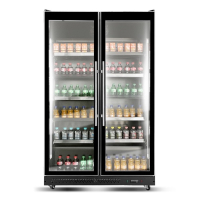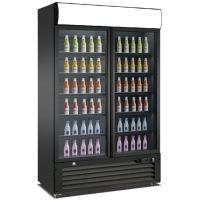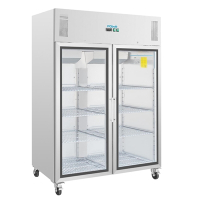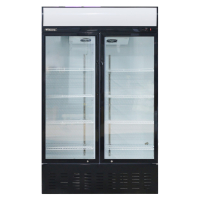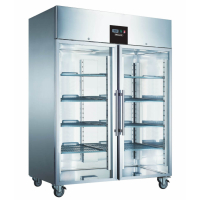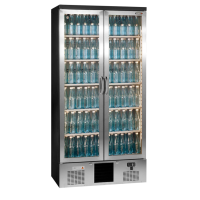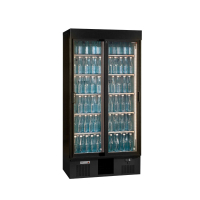Glass Door Display Fridges
Commercial Glass Door Display Fridges are essential investments for UK shops, cafés, and restaurants looking to showcase chilled products with maximum visual impact. These retail powerhouses combine crystal-clear visibility with precision temperature control (typically 2-10°C), making them perfect for displaying everything from drinks and sandwiches to desserts and dairy. With energy-efficient LED lighting and adjustable shelving, these fridges transform ordinary merchandise into eye-catching displays that drive impulse purchases. Whether you need a compact countertop model or a towering multi-deck refrigerator, these units work brilliantly alongside commercial freezers to create a complete chilled display solution that boosts your bottom line!
Explore More About Glass Door Display Fridges
Get expert guidance, see real chef stories, and find answers to your most common questions.
-
Commercial Upright Fridge | Single Glass Door Refrigerator | 336 Litre Capacity | Best Frost BR400G
68In Stock
1875H x 600W x 677D mm
13 amp plug fitted
336 Litres
2 front feet &2 rear rollers
£529.99 £1,320.00 -
Commercial Glass Door Display Fridge | Upright Single Door Refrigerator | 500L Capacity | BestFrost GDR500
135In Stock
1990H x 680W x 700D mm
13 amp plug fitted
576 Litres
White
£679.99 £1,334.00 -
Commercial Upright Drinks Fridge | Glass Door Display Refrigerator | LED Canopy | King KXG600H
95out of stock
1998H x 700W x 660D mm
13 amp plug fitted
489 Litres
Lightbox for sign or logo
£749.99 £1,080.00 -
Commercial Drinks Fridge | Glass Door Upright Refrigerator | 2 Door with LED Canopy | King KXG900H
155out of stock
1995H x 1120W x 635D mm
13 amp plug fitted
750 Litres
Precise Temperature Control: 2C to 8C
£899.99 £1,600.00 -
Commercial Drinks Fridge | Upright Display Fridge | 2 Sliding Glass Doors | LED Canopy | King KXG900S
155In Stock
1995H x 1120W x 635D mm
13 amp plug fitted
708 Litres
Integrated LED Canopy - ideal for logos or signs
£929.99 £1,600.00 -
Commercial Upright Glass Door Drinks Fridge | Beverage Display Cooler | Double Door | Black | King KXG1253
114out of stock
1997H x 1253W x 710D mm
13 amp plug fitted
1038 Litres
Ample Storage Space: Accommodates a wide variety of drink types and sizes.
£999.99 £1,500.00 -
Commercial Glass Door Display Fridge | Upright 2 Door Refrigerator | 950L Capacity | BestFrost GDR950
230In Stock
1990H x 1370W x 700D mm
13 amp plug fitted
1079 Litres
White
£999.99 £1,665.00 -
Commercial Upright Drinks Fridge | Sliding Glass Door Display | LED Canopy | King KXG1330S
142In Stock
1998H x 1330W x 760D mm
13 amp plug fitted
1136 Litres
Top-Mounted LED Canopy: Doubles as a striking sign for attention-grabbing display.
£1,099.99 £1,820.00 -
🎯 Need Help Choosing the Right Glass Door Display Fridges?
Discover how to choose the right model with expert advice on buying considerations, kitchen-tested usage tips, frequently asked questions and real-world chef insights below.
🎧 On the go? Listen to our expert podcast instead -
Commercial Glass Door Fridge | Drinks Cooler | 3 Door Display Refrigerator | King KXG1880
223In Stock
1997H x 1880W x 705D mm
13 amp plug fitted
1598 Litres
Easy Accessibility: Allows convenient access to drinks behind each glass door.
£1,499.99 £2,000.00 -
Commercial Glass Door Display Fridge | 3 Door Upright Refrigerator | 1400L Capacity | BestFrost GDR1400
360KGout of stock
1990H x 2048W x 700D mm
13 amp plug fitted
1547 Litres
White
£1,499.99 £2,505.00 -
Commercial Glass Door Fridge | Drinks Cooler | 3 Door Display Refrigerator | King KXG1680
184In Stock
1995H x 1680W x 635D mm
13 amp plug fitted
1190 Litres
Temp range 2c to 8C
£1,629.99 £2,300.00 -
Commercial Glass Door Fridge | 4 Door Drinks Cooler | 1059L Capacity | King KXG2240
out of stock
1995H x 2240W x 635D mm
13 amp plug fitted
1611 Litres
Black Exterior and Interior
£2,059.99 £3,060.00 -
Commercial Table Top Wine Fridge | Wine Cooler | 16 Bottle Capacity | Polar C-Series CB058
19In Stock
560H x 430W x 450D mm
13 amp plug fitted
48Ltr
Painted Steel
£135.99 £251.98 -
Commercial Display Fridge | Counter Top Display Refrigerator | 46 Litre Capacity | Polar DM071
17.5In Stock
510H x 430W x 480D mm
13 amp plug fitted
46Ltr
Time-saving easy-clean construction
£157.57 £295.14 -
Commercial Wine Fridge | Table Top Wine Cooler | 28 Bottle Capacity | Polar C-Series CC066
26In Stock
840H x 430W x 450D mm
13 amp plug fitted
74Ltr
Painted Steel
£163.89 £307.78 -
Commercial Under Counter Display Fridge | White Display Refrigerator | C-Series | Polar CF750
28.1In Stock
825H x 430W x 480D mm
13 amp plug fitted
88
Stainless Steel
£180.99 £341.98 -
Commercial Mini Bar | Wine & Bottle Cooler | 10 Bottle Capacity | Glass Door | Blizzard BMB30G
In Stock
480H x 400W x 420D mm
Blizzard
Double glazed glass door
Black
£287.99 £481.00 -
Commercial Mini Bar | Glass Door Wine Cooler | 24 Bottle Capacity | Blizzard BMB40G
In Stock
550H x 400W x 440D mm
Blizzard
Double glazed glass door
Black
£326.99 £546.00 -
Commercial Under Counter Display Fridge | 150L Capacity | White Finish | Polar C-Series CZ785
In Stock
855H x 600W x 619D mm
Polar
150
Stainless Steel
£387.99 £755.98 -
Commercial Display Fridge | Refrigerated Merchandiser | 218 Litre Capacity | Polar DM075
139In Stock
1692H x 530W x 575D mm
13 amp plug fitted
218Ltr
External White
£441.99 £863.98 -
Commercial Display Fridge | Refrigerated Display Cabinet | 322 Litre Capacity | Polar DM076
152out of stock
1982H x 620W x 570D mm
13 amp plug fitted
368Ltr
External White
£549.99 £1,079.98 -
Commercial Glass Door Display Fridge | Retail Refrigerator | 85L Capacity | Vestfrost M85
45 KGIn Stock
830H x 493W x 587D mm
13 amp plug fitted
138 Litres
Black
£647.99 £1,389.00 -
Commercial Back Bar Cooler | Upright Bar Fridge | Slimline 300L Glass Door | Polar CS586
85In Stock
1900H x 448W x 680D mm
Polar
300Ltr
Painted Steel & Glass
£702.99 £1,385.98 -
Commercial Undercounter Refrigerator | Glass Door Fridge | 145L Capacity | Blizzard UCR140CR
In Stock
819H x 598W x 613D mm
Blizzard
Height adjustable from 819mm to 850mm
Stainless Steel
£772.99 £1,292.00 -
Commercial Glass Door Merchandiser | Single Door Display Fridge | 350L Capacity | Blizzard BC350
In Stock
1905H x 592W x 605D mm
Blizzard
White prepainted aluminium interior
White
£841.99 £1,407.00 -
Commercial Glass Door Merchandiser | Refrigerator Display Fridge | 350L Capacity | Blizzard GD350
out of stock
2180H x 592W x 615D mm
Blizzard
White prepainted aluminium interior
White
£889.99 £1,487.00 -
Commercial Upright Glass Door Refrigerator | Gastro Fridge | 600 Litre Capacity | Polar CW197
150In Stock
2010H x 680W x 800D mm
Polar
10 x GN2/1 (100mm deep)
Stainless Steel
£891.99 £1,763.98 -
Commercial Glass Door Fridge | Drinks Cooler | 2-Door Beverage Display | King KXG1120
135In Stock
1995H x 1120W x 635D mm
13 amp plug fitted
770 Litres
Efficient Cooling System: Ensures beverages remain at optimal temperatures.
£999.99 £1,500.00 -
Commercial Drinks Fridge | Upright Display Refrigerator | 2 Hinged Glass Doors | LED Canopy | King KXG1330H
142In Stock
1998H x 1330W x 760D mm
13 amp plug fitted
1186 Litres
Top-Mounted LED Canopy: Doubles as a striking sign for attention-grabbing display.
£1,049.99 £1,850.00 -
Commercial Glass Single Door Upright Fridge | Retail Display Fridge | 306 Litres Capacity | Vestfrost M150
74 kgIn Stock
1550H x 595W x 595D mm
13 amp plug fitted
281 litre
Ventilated cooling
£1,060.99 £2,274.00 -
Commercial Double Glass Door Refrigerator | Upright Gastro Fridge | 1200 Litre Capacity | Polar CW198
180kgIn Stock
2010H x 1340W x 800D mm
Polar
20 x 2/1GN (100mm deep)
Stainless Steel
£1,269.99 £2,519.98 -
Commercial Glass Door Merchandiser | Double Door Display Fridge | 630L Capacity | Blizzard GD630
In Stock
2010H x 925W x 695D mm
Blizzard
White prepainted aluminium interior
White
£1,391.99 £2,326.00 -
Commercial Double Glass Sliding Door Merchandiser | Refrigerator Display | 908L Capacity | Blizzard GD900SL
In Stock
2010H x 1295W x 695D mm
Blizzard
White prepainted aluminium interior
White
£1,748.99 £2,924.00 -
Commercial Single Glass Door Gastronorm Freezer | Ventilated Catering Freezer | 650L Capacity | Blizzard BF1SSCR
In Stock
2010H x 740W x 858D mm
Blizzard
Internal corners rounded to aid cleaning
Stainless Steel
£2,034.99 £3,402.00 -
Commercial Gastronorm Refrigerator | Double Glass Door Fridge | 1300L Capacity | Blizzard BR2SSCR
In Stock
2010H x 1480W x 858D mm
Blizzard
Internal corners rounded to aid cleaning
Stainless Steel
£2,692.99 £4,501.00 -
Commercial Double Glass Door Freezer | Gastronorm Ventilated Freezer | 1300L Capacity | Blizzard BF2SSCR
In Stock
2010H x 1480W x 858D mm
13 amp plug fitted
Internal corners rounded to aid cleaning
Stainless Steel
£2,877.99 £4,810.00 -
Commercial Glass Double Door Display Fridge | Beverage Cooler | 500 Litre Capacity | Gamko MG3/500GCS
130In Stock
1800H x 900W x 530D mm
13 amp plug fitted
480 x 330ml bottles
Stainless Steel
£3,101.99 £6,648.00 -
Commercial Display Fridge | Glass Double Sliding Door | 500 Litre Capacity | Gamko MG3/500SD
130In Stock
1800H x 900W x 530D mm
13 amp plug fitted
480 x 330ml bottles
Black
£3,260.99 £6,987.00 -
Commercial Glass Door Display Fridge | Upright Refrigerator | 400 Litre Capacity | Foster FSL400G
90kgout of stock
1990H x 600W x 705D mm
13 amp plug fitted
400
Stainless Steel Outside / Aluminium Inside
£3,261.99 £6,990.00
Commercial Glass Door Display Fridges for Shops & Restaurants
Brands Trusted by Industry Professionals
Key Features and Benefits
- LED Display Lighting Illuminates products brilliantly while using less energy—perfect for showcasing merchandise.
- Temperature Control Digital thermostats maintain precise cooling—keeps products fresh and safe.
- Double-Glazed Doors Provides excellent insulation while allowing full product visibility—saves energy costs.
- Adjustable Shelving Customize your display to suit various product heights—maximizes space usage.
- Auto Defrost Maintains optimal performance without manual defrosting—saves time and hassle.
- Self-Closing Doors Automatically seal when released—prevents temperature loss during busy periods.
- Fan-Assisted Cooling Ensures even temperature throughout—no warm spots or freezing.
- Energy Efficiency Modern compressors and insulation reduce running costs—kinder to planet and pocket.
Too busy to read? Listen instead.
In this episode of The Deep Dive, we look at how glass door display fridges boost sales and presentation. Discover tips for selecting the right size, lighting, and energy efficiency features—ideal for cafes, shops, and foodservice displays.
14.25min | Expert-led | Real-world advice
0:00: Welcome to the deep dive.
0:02: Today we're zeroing in on something you see pretty much every day, but probably haven't given a whole lot of thought to commercial glass door display fridges.
0:12: Yeah, sounds a bit niche, maybe.
0:14: It might sound like a cold subject, huh, pun intended.
0:16: Oh, nice.
0:18: But honestly, there's a really surprising amount of like Retail strategy and clever engineering packed into these things.
0:27: Absolutely.
0:28: And we've got some great material to work with today, insights from easy equipment.
0:33: That's the one.
0:35: UK supplier been doing this for 50 years.
0:37: 50 years.
0:38: Wow, yeah, that's, that's some serious experience in the field.
0:41: They'll know what works exactly.
0:43: So our mission really is to get under the hood of these, these workhorses.
0:47: We want to figure out, you know, the basics, what businesses really need to think about when they buy one and crucially how they actually impact the bottom line, right?
0:55: And this isn't just for like shop owners listening in.
0:57: No, definitely not.
0:58: If you're just curious about how businesses sort of Nudge us towards buying things or even just interested in the, you know, the tech behind everyday stuff.
1:07: Yeah, the practical engineering.
1:08: There's some really cool stuff here.
1:10: Think about it.
1:10: Corner shops, cafes, restaurants, they all have them.
1:15: They're ubiquitous and easy equipment pointed out something right away that that grabbed me.
1:20: The sheer variety.
1:23: I mean, tiny little countertop ones for a few Wayne bottles all the way up to these huge multi-door units holding like over 1500 L.
1:32: That's massive.
1:33: It really shows how adaptable they need to be for different businesses.
1:37: It does.
1:38: But easy equipment says, you know, at their core.
1:41: The main job is that mix of visibility, seeing the products clearly and keeping them at just the right temperature.
1:47: Usually that kind of 2 to 10 °C range.
1:50: Yeah, the sweet spot for drinks, sandwiches, cakes, dairy.
1:54: All that stuff.
1:55: Pretty much the grab and go essentials, and they often work alongside commercial freezers, right?
1:59: Yeah, they mentioned that it's like a complete cold display setup.
2:02: A coordinated approach for everything chilled and frozen makes sense for places with a wide range.
2:08: But these glass door fridges, they're, they're more than just cold boxes, aren't they?
2:12: They've got a lot of features.
2:14: Oh yeah, they're pretty sophisticated now, packed with tech for specific benefits.
2:17: OK, let's get into those features then.
2:19: Easy equipment lists.
2:21: , LED lighting first.
2:23: Obvious benefit is seeing the stuff, right, better presentation, but it's also about energy efficiency.
2:29: LEDs use way less power.
2:32: OK, lower bills.
2:33: Exactly, big saving for businesses running refrigeration 224/7, and that bright light, it just makes the products look, you know, fresher, more appealing.
2:43: It's a subconscious thing.
2:44: A silent visual cue.
2:46: I like that.
2:47: OK, next.
2:49: Digital thermostats, more precise than the old dials.
2:53: Much more precise, and that accuracy is key, not just for keeping things tasting good, but for safety too, I guess.
2:58: Absolutely.
2:58: Food safety regs demand tight temperature control, stops nasty bacteria growing.
3:03: It's non-negotiable, right?
3:05: Then double grazed doors.
3:07: That's mainly for insulation, keeping the cold in.
3:09: Primarily, yeah, grade insulation means less energy needed to keep it cool, especially if doors are opened a lot.
3:15: Exactly.
3:16: Plus it stops condensation building up on the glass.
3:19: You need that clear view.
3:21: People won't buy what they can't see properly.
3:23: Good point.
3:24: Adjustable shelving seems Pretty basic.
3:27: It is basic but essential.
3:29: It's about flexibility, fitting different sized products in tall bottles, small tubs, yeah, and arranging them to look good, maximizing that display space effectively.
3:39: Retailers can experiment with layouts.
3:41: Auto defrost, that sounds like a lifesaver.
3:43: No more chipping away ice.
3:45: yeah, nobody.
3:46: wants that job.
3:47: Auto defrost prevents ice building up on the cooling coils automatically, which would make it less efficient otherwise.
3:53: Totally.
3:53: Ice acts like insulation where you don't want it, so auto defrost keeps it running smoothly, no hassle.
3:59: And self-closing doors, we've all felt those pushback.
4:02: Important for busy times.
4:03: Definitely.
4:04: Staff are rushing, customers might forget.
4:06: These doors make sure that cold air doesn't just pour out.
4:09: Saves energy again constantly.
4:10: It's a small thing with a big impact on running costs over time.
4:14: OK, and fans assisted cooling.
4:16: Why the fan inside?
4:17: It's all about even temperature distribution.
4:20: Without a fan, you can get warm spots.
4:22: So the stuff at the back might be colder than the stuff at the front.
4:25: Potentially, yeah.
4:26: The fan circulates the cold air everywhere, top to bottom, front to back, ensures everything stays properly chilled.
4:34: Got it.
4:35: And lastly, overall energy efficiency, modern compressors, insulation.
4:41: It it all comes back to cost, doesn't it?
4:43: It really does.
4:44: Energy prices being what they are, efficiency isn't a nice to have.
4:48: It's crucial for profitability.
4:50: An efficient model pays for itself over time.
4:52: OK, so definitely not just simple boxes, lots of tech in there.
4:56: But if you're a business owner looking to buy one, what are the key things to consider?
5:00: Easy equipment, heads and pointers?
5:02: Yeah, top of the list, capacity and size, and not just how much it holds, but the physical dimension.
5:07: Exactly.
5:08: Measure your floor space carefully.
5:10: And crucially, measure doorways, corridors, make sure you can actually get the thing into the building.
5:16: , yeah, that would be an expensive mistake.
5:19: Happens more than you'd think.
5:20: Then there's the internal capacity.
5:22: They mentioned a busy cafe needing maybe 400 L or more.
5:25: Right.
5:26: How do you estimate that?
5:27: You need to think about your peak sales volume.
5:30: How much stock do you need readily available during your busiest hours?
5:34: And look at your product sizes too.
5:35: Definitely.
5:37: Check the shelf dimensions.
5:39: Will your bestselling tall bottles or wide platters actually fit properly and look good?
5:45: Makes sense.
5:45: Don't want things crammed in or falling over.
5:48: Then energy and performance.
5:50: We talked energy ratings, but what's this climate class?
5:53: , right.
5:54: Climate class tells you.
5:55: the maximum room temperature the fridge can handle efficiently.
5:59: So if it's in a hot kitchen, you need a higher climate class like 4 or 5.
6:03: Otherwise it'll struggle, work too hard, and use loads more energy or just won't keep things cold enough.
6:09: And noise levels too, they mentioned.
6:11: Yeah, important if it's out front with customers.
6:13: You don't want a loud humming distracting from the atmosphere.
6:16: OK, so it's about matching the fridge to its environment, right?
6:19: We know what they do, what to look for.
6:21: How do they actually work?
6:23: The chilling process?
6:24: Well, it's the standard refrigeration cycle, basically.
6:28: Warm air from inside the cabinet gets pulled over super cold evaporator coils, coils with refrigerant gas inside.
6:35: Exactly.
6:36: The refrigerant absorbs the heat from the air, cooling the air down.
6:39: Then the compressor squeezes that refrigerant, makes it hot, and dumps the heat outside the fridge, usually through coils at the back.
6:47: Precisely, and that cycle just keeps repeating to maintain the cold temperature inside.
6:52: And the double or triple glazed doors are like a shield, keeping that cold in and heat out.
6:58: Perfect analogy, they minimize heat transfer, which is essential for efficiency and keeping the the.
7:03: Temperatures stable.
7:04: While the digital thermostat is the brain, constantly checking and telling the system when to cool more.
7:09: Yep, maintaining that precise 2 to 10 degree range or whatever it's set to keeps things safe and looking good.
7:15: In the fans, spread that cold air evenly.
7:19: Make sure there are no warm spots, and those self-closing doors with magnetic seals just snap shut to stop leaks.
7:25: Simple but effective, especially with frequent opening.
7:29: And the autodefrost kicks in periodically to melt any ice off the coils.
7:33: Keeps it working efficiently.
7:35: OK, mechanics understood.
7:37: Now, easy equipment brought in an expert, Liam Sinclair.
7:40: Yeah, a refrigeration specialist.
7:41: He made a great point.
7:42: These fridges aren't just appliances.
7:44: What he called a silent sales team.
7:47: Oh, I like that.
7:48: Yeah, really highlights their role in merchandizing.
7:50: He stressed the importance of that LED lighting and the double glazing for, you know, both showing off the products and saving energy.
7:56: Silent sales team.
7:58: That really changes how you think about them.
8:01: OK, beyond selling stuff, safety is huge.
8:04: What guidelines did easy equipment give?
8:07: Liam and the team really hammered home daily temperature checks.
8:10: It's a must for food safety compliance.
8:12: Log it every day.
8:13: Non-negotiable.
8:14: And that 10 centimeter clearance around the unit needs airflow to breathe, stops the compressor overheating, right?
8:20: Don't box it in.
8:21: What else?
8:22: Don't overload shelves.
8:23: Obvious risk of collapse, but it also blocks airflow inside, leading to uneven cooling.
8:28: Use dedicated power sockets.
8:30: Don't overload circuits.
8:31: Clean the condenser coils regularly, monthly is good.
8:34: Where are they usually?
8:35: Back or bottom?
8:36: They get dusty, makes the fridge work harder, and clean up spills inside immediately, slips, contamination.
8:43: Basic hygiene, all very practical stuff.
8:45: So you've got the right fridge, it's safe.
8:48: How do you make it sell more?
8:49: Top tips for usage.
8:51: Merchandizing is key.
8:53: Group similar products together makes it easy for customers to find things.
8:56: Logical layout and the golden rule, bestsellers, high profit items, put them right at eye level.
9:04: Prime retail space.
9:05: Absolutely.
9:05: That's where people look first.
9:07: What else?
9:07: Keep those glass doors sparkling clean, daily wipe down with non-streaky cleaner.
9:12: Visibility is everything.
9:14: And again, don't cram the shelves.
9:15: Allow air to circulate for drinks.
9:18: Line them up neatly, maybe bottlenecks forward.
9:20: Looks professional.
9:21: Little details matter.
9:22: Check door seals weekly for cracks or damage.
9:24: Leaky seals waste a ton of energy.
9:27: And final tip.
9:28: Use a separate fridge thermometer sometimes.
9:30: Check the digital display is accurate.
9:33: Exactly.
9:33: Crucial double check for food safety can't rely solely on the built-in display.
9:38: Good point.
9:39: OK, lots of actionable tips there.
9:40: So, the bottom line, what are the big benefits for a business?
9:44: Well, number one, increased sales.
9:47: That visibility drives impulse buys big time.
9:50: People see it, they want it.
9:51: Exactly.
9:52: Easy self-service access improves customer experience too.
9:55: Quick grab and go, less waiting, and a huge one.
9:59: Reduced wastage.
10:01: Proper cooling means the longer shelf life for perishable goods.
10:04: That's direct cost saving, less food thrown away.
10:08: Huge for profitability, especially food.
10:10: Now they had a did you know section.
10:12: Some surprising facts in there.
10:13: Yeah, a couple of crackers, that eye level placement.
10:16: Apparently products there can sell up to 35% faster.
10:19: Wow, 35%.
10:20: That's significant.
10:21: Really shows the power of placement.
10:23: Also, a good quality unit should last about 7 to 10 years in a commercial setting, useful for planning.
10:28: Good lifespan.
10:29: What else?
10:29: The LED lighting thing produces 70% less heat than old fluorescent.
10:33: So the fridge doesn't have to work as hard to counteract the heat from its own lights.
10:37: Exactly, double efficiency win there and well merchandised fridges can apparently boost drink sales specifically by up to 25%, 25% just from arranging drinks nicely in a lit fridge.
10:50: Seems so powerful stuff.
10:52: Impressive numbers.
10:54: They quoted another specialist too, Sarah.
10:56: Yeah, she echoed the silent sales team idea and she really emphasized placement within the store, put them near the till for those last minute impulse buys, capture them while they're queuing, yeah.
11:07: She mentioned seeing up to a 30% increase in impulse sales with well-lit, well-placed displays.
11:13: So location, location, location applies to fridges too.
11:16: OK, pros and cons.
11:17: What's the summary?
11:18: Pros are pretty clear.
11:19: Great visibility, drives sales, keeps products at the perfect temp.
11:23: The main Energy use.
11:24: They generally use more power than solid door fridges just because of the glass, but they advise mitigating that.
11:29: Yeah, keep them away from heat sources, ovens, direct sunlight that helps manage the energy consumption.
11:34: Makes sense.
11:35: So who needs these?
11:36: It seems like a wide range.
11:37: Oh, huge range.
11:38: cafes for grab and go, drinks, desserts, convenience stores, absolutely essential for drinks, sandwiches, dairy, impulse buys galore, desserts, wine displays, maybe some prepped items, boost those extra sales, supermarkets obviously for entire aisles of drinks and chilled goods, enhances the shopping trip.
11:58: Very versatile, and they had a real world example.
12:01: A success story.
12:02: Yeah, a sandwich shop in Bristol.
12:05: Their afternoon sales were slow.
12:08: They put in a big triple door LED lit fridge right by the entrance, stocked it well, meal deals at eye level, good signage, 40% increase in overall sales in the first month.
12:18: 40%.
12:19: Wow.
12:19: The owner put it down to visibility, looking fresher, and customer seeing options easily without even opening the door, just seeing the offer clearly.
12:26: A fantastic example of putting it all together.
12:28: OK, finally, FAQs, let's rattle through some common ones.
12:31: Temperature range again.
12:33: Generally, 2 to 5 °C for food safety.
12:36: Maybe 8 to 10 for some drinks.
12:38: Depends on the product.
12:40: Cleaning condenser coils.
12:41: How often?
12:41: Monthly is the recommendation.
12:43: Keep them clean for efficiency.
12:44: Can you get models for undercounter?
12:47: Built-in look.
12:48: Yep, under counter models are definitely available.
12:50: Good space savers, fan assisted versus static cooling.
12:53: Fan assisted is generally better for commercial use, more even cooling.
12:58: Can you use them outside for events?
13:00: Yes, but you need the right climate class 4 or 5 built for warmer ambient temps, and the big one, running costs.
13:08: Per day they estimate around 1 to 3 pounds per day for efficient models, but it really varies with size, usage, efficiency rating, and how warm the room is.
13:17: Gives a ballpark figure though.
13:19: OK, well, we've definitely, plumbed the depths of display fridges today.
13:23: I really have.
13:24: What's your main takeaway from all this?
13:26: For me, it's just reinforcing that there's so much more than cooling units.
13:29: They're active merchandizing tools, sales teams.
13:32: Exactly, driving sales, ensuring quality, ensuring safety.
13:36: It's a mix of engineering and kind of retail psychology.
13:40: Yeah, my aha moment was connecting all those features, the lights, the glass, the shelves, directly to the bottom line, how Epart contributes.
13:48: It's way more strategic than I thought.
13:51: It really is a surprisingly powerful piece of kit in the commercial world, often overlooked.
13:57: So, here's a final thought for you, the listener.
14:00: Next time you're in a shop, cafe, restaurant, wherever, just pause for a second and look at those glass door fridges.
14:08: Notice how things are arranged where the fridge is.
14:11: What strategies are they using?
14:12: Exactly, what subtle things are going on, how might it be influencing what you feel like buying?
14:18: It's a, a surprisingly strategic, chilled world out there.
14:23: Well put.
14:23: Thanks for diving in with us today.

Essential Buying Considerations
Capacity and Size
- Consider available floor space—measure doorways for delivery access.
- Calculate capacity needed—a busy café might need 400+ litre capacity.
- Check shelf dimensions against your largest products.
Energy and Performance
- Look for A+ energy ratings—pair with efficient lighting systems.
- Choose climate class appropriate for your shop environment.
- Consider noise levels—especially important for shop floor placement.
How Commercial Glass Door Display Fridges Work
These clever cooling wonders operate using a refrigeration system that pulls warm air across an evaporator, cooling it before circulating the chilled air throughout the cabinet. The double or triple-glazed glass doors provide excellent insulation while maintaining perfect visibility—like having a window into a perfectly chilled world. Digital thermostats maintain precise temperatures between 2-10°C, while strategically placed fans ensure even cooling from top to bottom. Most units feature self-closing doors with magnetic seals to maintain temperature when busy staff move between tasks, and automatic defrost systems prevent ice buildup—keeping everything running smoothly all day long!

Trusted Insights from Liam Sinclair
![]()
Refrigeration Specialist
13+ years experience
Safety Guidelines
- Temperature Monitoring Check readings daily—ensures food safety compliance.
- Ventilation Space Leave 10cm clearance around units—prevents overheating.
- Weight Distribution Avoid overloading shelves—prevents collapse.
- Electrical Safety Use dedicated power points—avoids circuit overloads.
- Condenser Cleaning Schedule regular cleaning—maintains cooling efficiency.
- Spillage Management Clean spills immediately—prevents slips and contamination.
Top Tips for Using Commercial Glass Door Display Fridges
For maximum impact, arrange products by category and keep best-sellers at eye level—this is prime retail territory! Clean glass doors daily with a non-streaking cleaner to maintain crystal-clear visibility, and avoid overloading shelves which blocks airflow. Keep drinks merchandising logical and straight with bottle necks facing forward. Check door seals weekly for damage, and use a fridge thermometer to verify your digital display is accurate—crucial for food safety compliance.
Benefits of Using Commercial Glass Door Display Fridges
- Increased Sales Clear visibility boosts impulse purchases—drives revenue growth.
- Enhanced Customer Experience Self-service access speeds up service—improves satisfaction.
- Reduced Wastage Proper cooling extends product life—saves on inventory costs.
Did You Know?
- Visibility Impact Products at eye level sell 35% faster than those on bottom shelves.
- Durability Quality display fridges typically last 7-10 years in commercial settings.
- LED Advantage LED lighting produces 70% less heat than fluorescent—keeps cooling costs down.
- Sales Boost Well-merchandised display fridges can increase drink sales by up to 25%.




Expert Insights on Commercial Glass Door Display Fridges
After supplying display fridges to thousands of UK businesses over 50 years, we've seen how crucial visibility is to sales. 'A well-lit display fridge can increase impulse purchases by up to 30%,' explains Sarah, our refrigeration specialist. 'The right placement near till points can transform browsing into buying.'
- Pros: Enhances product visibility, drives impulse sales, maintains perfect temperature.
- Cons: Higher energy usage than solid door models—position away from heat sources.
Who Needs Commercial Glass Door Display Fridges?
- Cafés Perfect for grab-and-go sandwiches, drinks and desserts—speeds up service.
- Convenience Stores Essential for displaying chilled drinks, sandwiches and dairy—drives impulse buys.
- Restaurants Showcases desserts, wines and prepared items—boosts premium add-ons.
- Supermarkets Vital for beverage sections and chilled goods—enhances shopping experience.
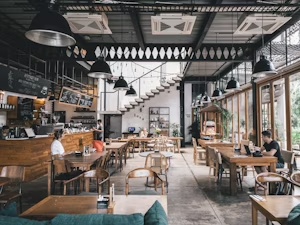
Real-World Success with Commercial Glass Door Display Fridges
A bustling sandwich shop in Bristol was struggling with declining afternoon sales. After installing one of our triple-door display fridges with LED lighting at the entrance, pre-made sandwiches and drinks became instantly more visible. They strategically placed their grab-and-go meal deals at eye level and used promotional signage alongside the fridge. 'Sales jumped 40% in the first month,' the manager told us. 'The lighting makes everything look fresher, and customers can see options clearly without opening doors. It's transformed our business!'

FAQs
- What temperature should a commercial display fridge maintain? Between 2-5°C for food safety, adjustable to 8-10°C for some beverages.
- How often should I clean the condenser coils? Monthly cleaning prevents overheating and extends compressor life.
- Can display fridges be built into counters? Yes, undercounter models are designed specifically for this purpose.
- What's the difference between fan-assisted and static cooling? Fan-assisted provides more even cooling—better for commercial environments.
- Are display fridges suitable for outdoor events? Choose climate class 4 or 5 for outdoor use—handles higher ambient temperatures.
- How much does it cost to run a display fridge? Energy-efficient models cost £1-3 per day depending on size and usage.
Looking for Equipment by Business Type?
Not sure where to start? Whether you're running a bustling café, opening a pizzeria, or managing a school canteen, we've made it easy to shop by business type. Explore handpicked equipment bundles and essentials tailored to your industry—saving you time and making sure you get exactly what you need.
Other Categories You Might Find Useful
We’ve selected some closely related categories that might be essential for your setup. Whether you’re expanding your kitchen or just making sure you’ve got everything covered, these links will help you explore more equipment that fits your needs.
What our Customers Say
'Our display fridge has boosted drink sales by 30%—brilliant investment!'
M Mike Corner Shop Owner, Leeds'Crystal-clear doors and perfect temperature control—worth every penny.'
C Charlotte Café Manager, Glasgow
Why Choose EasyEquipment for Commercial Glass Door Display Fridges?
- Trusted Supplier 50 years supplying UK businesses—unmatched experience.
- Nationwide Delivery Fast, reliable shipping across the UK—arrives when you need it.
- Best Price Promise Find it cheaper? We'll match it—guaranteed value.
- Expert Support Dedicated team to help you choose—not just sell.
Ready to Explore Commercial Glass Door Display Fridges?
Browse our complete range of display refrigeration solutions with options for every business size and budget. From compact countertop models to impressive multi-deck displays, we'll help you find the perfect solution to showcase your products and boost sales!
#DisplayFridge
- #CommercialRefrigeration
- #RetailEquipment
- #ShopFittings
- #CafeEquipment
- #GlassDoorFridge
- #EasyEquipment
- #FoodRetail

